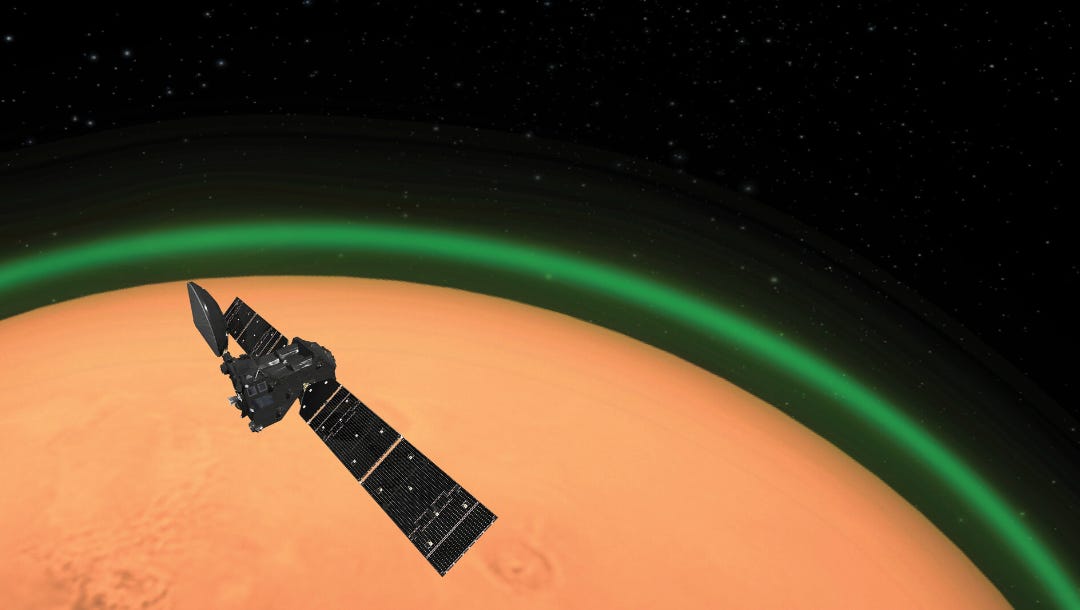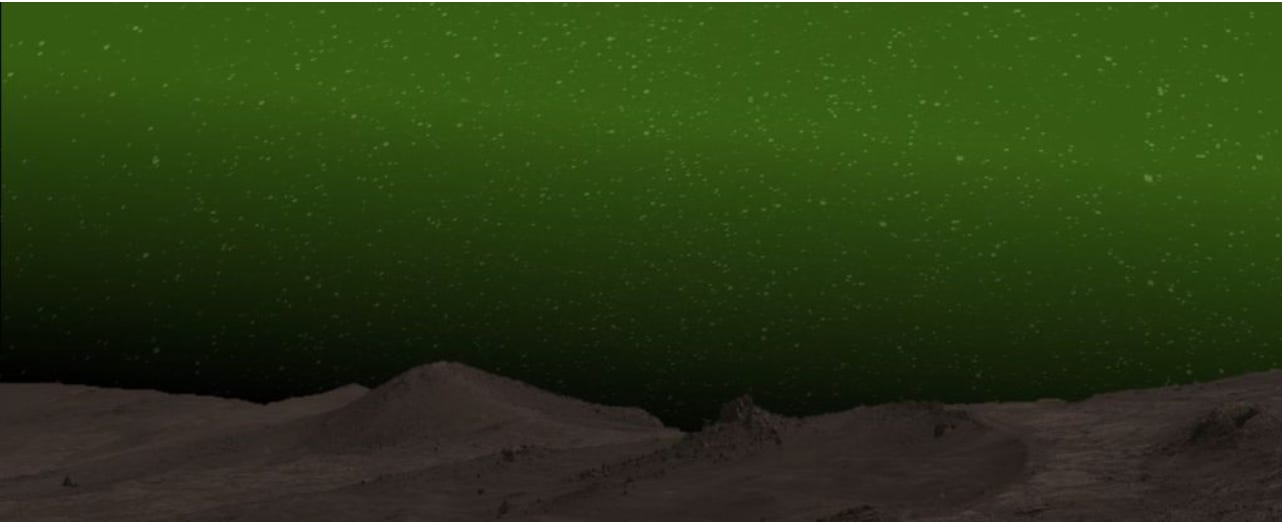The Red Planet Has a Green Sky
Scientists discovered Mars has a visible dayglow, making it the only other planet we know of with one besides Earth
Hiya!
I’ve recently realized that many of my thoughts revolve around pondering two things — why something is the way it is and wondering what it might be like if it were another way. For instance, like most kids, I wondered why the grass is green and the sky is blue. Then I’d try to imagine what it would be like if it were flipped — if the grass was blue and the sky was green.
Unfortunately for me, visualizing such a scene was admittedly challenging since my visual mind was dim and foggy at best — it still is. But luckily for me, thanks to new research, I can now see what a green sky could look like. Except instead of Earth, it’s the rocky red planet Mars that has a green glow in its skies.
Previous Research
The European Space Agency’s (ESA) Mars Express orbits the red planet to study “the Martian atmosphere and climate, the planet’s structure, its mineralogy, and its geology, and to search for traces of water.”
About a decade ago, in 2012, scientists noticed the Mars Express detected a nightglow in infrared wavelengths in Mars’s atmosphere for the first time and published their discovery in the Journal of Geophysical Research.
As intriguing as the finding was, it wasn’t revolutionary since many planets, including Earth, have nightglows (but we’ll talk more about that later). Also, our eyes don’t register infrared waves, so while it was cool to learn Mars has a nightglow, it’s not like we could see it with our bare eyes.
Then, in 2020, the ESA’s ExoMars Trace Gas Orbiter (TGO) — which searches for trace atmospheric gases that could signal active biological or geological processes on Mars — detected glowing green oxygen atoms in the visible spectrum and on the planet’s dayside. This discovery is more exciting than the earlier one because Earth is the only planet we know of with a dayglow.
New Research
Intrigued by the previous research, planetary scientist Jean-Claude Gérard of the STAR Institute, Université de Liège, in Belgium, and his colleagues decided to take another look for themselves.
Among the instruments aboard the TGO is the NOMAD, which has three spectrometers that measure light absorption by chemical substances. Two spectrometers work in the infrared-wave range, while the third works in the UV-visible field.
The scientists pointed the TGO and its instruments at the edge of Mars’ atmosphere, searching for signs of the glow. Then, during the Martian winter on the south pole between altitudes of 25 to 37 miles (40 and 60 kilometers), they spotted it — a visible nightglow in the skies of Mars. They published their research in Nature Astronomy.

After further analysis, the researchers concluded that oxygen atoms from the sunny Martian day combine into dioxygen (O2) during the night, creating the eerie green glow in the process, likely bright enough to see from the ground.
If you understand what the chemical part means, then props to you because I had no idea. However, if you’re like me, and your brain went to mush thinking about the explanation, then don’t worry. I figured it out for both of us.
What Exactly is the Glow
The research I’ve told you about mostly focuses on nightglow, but technically, the effect is called airglow. The terms “dayglow” or “nightglow” refer to the time range in which the glow occurs — either during the day or night.
At first, I thought airglow was kinda like Earth’s northern lights, but it turns out that while airglow shares some visual similarities with Earth’s aurora, the two are distinct phenomena.
The National Aeronautics and Space Administration (NASA) explains airglow happens “when atoms and molecules in the upper atmosphere, excited by sunlight, emit light in order to shed their excess energy.”
See, during the day, photodissociation occurs, which is when sunlight splits molecules apart. Then, at night, when a planet’s surface is facing away from the harsh solar radiation, loose atoms recombine into molecules once again. Doing so allows them to release their excess energy as photons, creating a glow during the transformation.
So, airglow occurs when atoms and molecules shed their excess energy once they’re out of direct sunlight. Meanwhile, the northern lights happen when charged particles from the sun interact with Earth’s magnetic field. While different phenomena, like the aurora, other planets in our solar system have some sort of airglow.
Looking at Earth from space, our planet’s nightglow has layers of gold, green, and hints of reddish light, depending on which molecules are swirling in the atmosphere. Meanwhile, the nightglow on Venus is infrared, which is invisible to our eyes. Jupiter’s nightglow was thought to be mostly made of ultraviolet light, but an early 2000s flyby of the New Horizons found far less UV light in the planet’s nightglow than expected.
In the Future
Even though planetary airglows aren’t rare, the one on Mars is special and can tell us a lot about the red planet. Gérard, Liège planetologist and lead researcher of the new study explained in a statement by the ESA:
"The intensity of the night glow in the polar regions [of Mars] is such that simple and relatively inexpensive instruments in Martian orbit could map and monitor atmospheric flows. A future ESA mission could carry a camera for global imaging. In addition, the emission is sufficiently intense to be observable during the polar night by future astronauts in orbit or from the Martian ground.”
Mars has a very thin atmosphere, and studying the airglows can help scientists figure out why. Understanding how the atmosphere on Mars works is crucial for future exploration. For instance, such knowledge would do wonders for designing a spacecraft specifically for traveling to Mars.
Scientists could also construct satellites capable of staying in the Martian atmosphere without getting dragged down. At the very least, experts could design parachutes capable of sending down payloads to the planet’s surface.
Perspective Shift
Gosh, Nature is cool. It’s bewitching to observe when you know nothing about science. Yet, even when the curtain is lifted, and things like why Earth’s sky is blue while the Martian sky is sometimes green are explained, it doesn’t diminish any wonder Nature inspires. If anything, Nature becomes more impressive and magical the more you learn about it.
Still, as incredible as Mars’s green nightglow would be to witness firsthand, I have zero-zip-nada interest in traveling there to see it. I’ll stay right here on Earth, thank you very much. Still, the images of the eerie sky satisfy my childhood curiosity of wondering what the sky might look like if it were green.
Just as a reminder, you’re currently reading my free newsletter Curious Adventure. If you’re itching for more, you’ll probably enjoy my other newsletter, Curious Life, which you’ve already received sneak peeks of on Monday mornings. The subscription fee goes toward helping me pay my bills so I can continue doing what I love — following my curiosities and sharing what I learn with you.
You can find more of my writing on Medium, where you can read mine and thousands of other indie writers to your heart’s content.
Lastly, if you enjoy my work and want to show me support, you can donate to my PalPal or my Ko-fi page, where you can also commission me to investigate a curiosity of your own! Thank you for reading. I appreciate you.




